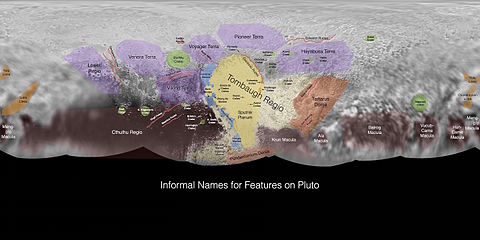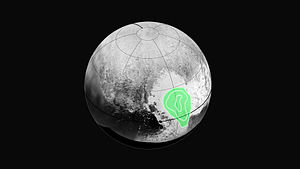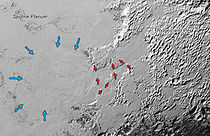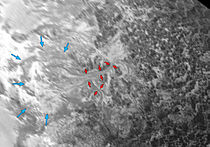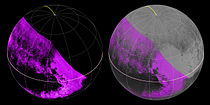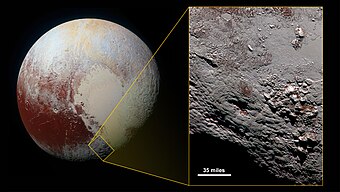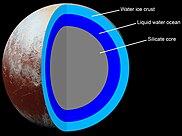
Triton is the largest natural satellite of the planet Neptune. It is the only moon of Neptune massive enough to be rounded under its own gravity and hosts a thin but well-structured atmosphere. Triton orbits Neptune in a retrograde orbit—an orbit in the direction opposite to its planet's rotation—the only large moon in the Solar System to do so. Triton is thought to have once been a dwarf planet, captured from the Kuiper belt into Neptune orbit.

Pluto is a dwarf planet in the Kuiper belt, a ring of bodies beyond the orbit of Neptune. It is the ninth-largest and tenth-most-massive known object to directly orbit the Sun. It is the largest known trans-Neptunian object by volume, by a small margin, but is less massive than Eris. Like other Kuiper belt objects, Pluto is made primarily of ice and rock and is much smaller than the inner planets. Pluto has roughly one-sixth the mass of Earth's moon, and one-third its volume.

Charon, known as (134340) Pluto I, is the largest of the five known natural satellites of the dwarf planet Pluto. It has a mean radius of 606 km (377 mi). Charon is the sixth-largest known trans-Neptunian object after Pluto, Eris, Haumea, Makemake, and Gonggong. It was discovered in 1978 at the United States Naval Observatory in Washington, D.C., using photographic plates taken at the United States Naval Observatory Flagstaff Station (NOFS).

Enceladus is the sixth-largest moon of Saturn and the 19th-largest in the Solar System. It is about 500 kilometers in diameter, about a tenth of that of Saturn's largest moon, Titan. It is mostly covered by fresh, clean ice, making it one of the most reflective bodies of the Solar System. Consequently, its surface temperature at noon reaches only −198 °C, far colder than a light-absorbing body would be. Despite its small size, Enceladus has a wide variety of surface features, ranging from old, heavily cratered regions to young, tectonically deformed terrain.

Tholins are a wide variety of organic compounds formed by solar ultraviolet or cosmic ray irradiation of simple carbon-containing compounds such as carbon dioxide, methane or ethane, often in combination with nitrogen or water. Tholins are disordered polymer-like materials made of repeating chains of linked subunits and complex combinations of functional groups, typically nitriles and hydrocarbons, and their degraded forms such as amines and phenyls. Tholins do not form naturally on modern-day Earth, but they are found in great abundance on the surfaces of icy bodies in the outer Solar System, and as reddish aerosols in the atmospheres of outer Solar System planets and moons.

A cryovolcano is a type of volcano that erupts gases and volatile material such as liquid water, ammonia, and hydrocarbons. The erupted material is collectively referred to as cryolava; it originates from a reservoir of subsurface cryomagma. Cryovolcanic eruptions can take many forms, such as fissure and curtain eruptions, effusive cryolava flows, and large-scale resurfacing, and can vary greatly in output volumes. Immediately after an eruption, cryolava quickly freezes, constructing geological features and altering the surface.

Penitentes, or nieves penitentes, are snow formations found at high altitudes. They take the form of elongated, thin blades of hardened snow or ice, closely spaced and pointing towards the general direction of the sun.

The Diacria quadrangle is one of a series of 30 quadrangle maps of Mars used by the United States Geological Survey (USGS) Astrogeology Research Program. The quadrangle is located in the northwestern portion of Mars' western hemisphere and covers 180° to 240° east longitude and 30° to 65° north latitude. The quadrangle uses a Lambert conformal conic projection at a nominal scale of 1:5,000,000 (1:5M). The Diacria quadrangle is also referred to as MC-2. The Diacria quadrangle covers parts of Arcadia Planitia and Amazonis Planitia.
Scalloped topography is common in the mid-latitudes of Mars, between 45° and 60° north and south. It is particularly prominent in the region of Utopia Planitia, in the northern hemisphere, and in the region of Peneus and Amphitrites Paterae in the southern hemisphere. Such topography consists of shallow, rimless depressions with scalloped edges, commonly referred to as "scalloped depressions" or simply "scallops". Scalloped depressions can be isolated or clustered and sometimes seem to coalesce. A typical scalloped depression displays a gentle equator-facing slope and a steeper pole-facing scarp. This topographic asymmetry is probably due to differences in insolation. Scalloped depressions are believed to form from the removal of subsurface material, possibly interstitial ice, by sublimation. This process may still be happening at present. This topography may be of great importance for future colonization of Mars because it may point to deposits of pure ice.
Planetary oceanography, also called astro-oceanography or exo-oceanography, is the study of oceans on planets and moons other than Earth. Unlike other planetary sciences like astrobiology, astrochemistry, and planetary geology, it only began after the discovery of underground oceans in Saturn's moon Titan and Jupiter's moon Europa. This field remains speculative until further missions reach the oceans beneath the rock or ice layer of the moons. There are many theories about oceans or even ocean worlds of celestial bodies in the Solar System, from oceans made of diamond in Neptune to a gigantic ocean of liquid hydrogen that may exist underneath Jupiter's surface.

Tombaugh Regio, sometimes nicknamed "Pluto's heart" after its shape, is the largest bright surface feature of the dwarf planet Pluto. It lies just north of Pluto's equator, to the northeast of Belton Regio and to the northwest of Krun Macula, which are both dark features. Its western lobe, a 1,000 km (620 mi)-wide plain of nitrogen and other ices lying within a basin, is named Sputnik Planitia. The eastern lobe consists of high-albedo uplands thought to be coated by nitrogen transported through the atmosphere from Sputnik Planitia, and then deposited as ice. Some of this nitrogen ice then returns to Sputnik Planitia via glacial flow. The region is named after Clyde Tombaugh, the discoverer of Pluto.

Belton Regio is a prominent surface feature of the dwarf planet Pluto. It is an elongated dark region along Pluto's equator, 2,990 km (1,860 mi) long and one of the darkest features on its surface.

The geology of Charon encompasses the characteristics of the surface, crust, and interior of Pluto's moon Charon. Like the geology of Pluto, almost nothing was known of Charon's geology until the New Horizons of the Pluto system on 14 July 2015. Charon's diameter is 1,208 km (751 mi)—just over half that of Pluto. Charon is sufficiently massive to have collapsed into a spheroid under its own gravity.

The geography of Pluto is mainly focused the distribution of physical features across Pluto. On 14 July 2015, the New Horizons spacecraft became the first spacecraft to fly by Pluto. During its brief flyby, New Horizons made detailed geographical measurements and observations of Pluto and its moons.

Sputnik Planitia is a large, partially glaciated basin on Pluto. About 1,400 by 1,200 km in size, Sputnik Planitia is partially submerged in large, bright glaciers of nitrogen ice. Named after Earth's first artificial satellite, Sputnik 1, it constitutes the western lobe of the heart-shaped Tombaugh Regio. Sputnik Planitia lies mostly in the northern hemisphere, but extends across the equator. Much of it has a surface of irregular polygons separated by troughs, interpreted as convection cells in the relatively soft nitrogen ice. The polygons average about 33 km (21 mi) across. In some cases troughs are populated by blocky mountains or hills, or contain darker material. There appear to be windstreaks on the surface with evidence of sublimation. The dark streaks are a few kilometers long and all aligned in the same direction. The planitia also contains pits apparently formed by sublimation. No craters were detectable by New Horizons, implying a surface less than 10 million years old. Modeling sublimation pit formation yields a surface age estimate of 180000+90000
−40000 years. Near the northwest margin is a field of transverse dunes, spaced about 0.4 to 1 km apart, that are thought to be composed of 200-300 μm diameter particles of methane ice derived from the nearby Al-Idrisi Montes.

The Hillary Montes or are a mountain range that reach 3.5 km above the surface of the dwarf planet Pluto. They are located northwest of Tenzing Montes in the southwest border area of Sputnik Planitia in the south of Tombaugh Regio. The Hillary Montes were first viewed by the New Horizons spacecraft on 14 July 2015, and announced by NASA on 24 July 2015.

Wright Mons is a large, roughly circular mountain and likely cryovolcano on the dwarf planet Pluto. Discovered by the New Horizons spacecraft in 2015, it is located southwest of Sputnik Planitia within Hyecho Palus, adjacent to the Tenzing Montes and Belton Regio. A relatively young geological feature, Wright Mons has attracted attention as one of the most apparent examples of recent geological activity on Pluto and borders numerous other similarly young features. Numerous semi-regular hills surround and partially construct the flanks of Wright Mons. Their nature remains unexplained, with few, if any, direct analogs elsewhere in the Solar System.
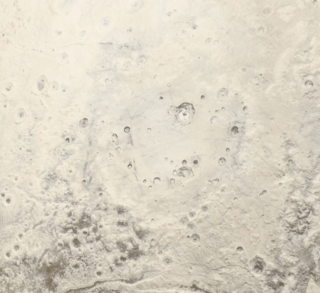
Burney, sometimes referred to as the Burney basin, is a large multi-ringed impact basin on the dwarf planet Pluto. With a diameter of over 290 kilometers, it is the second-largest known impact basin on Pluto, after the Sputnik Planitia basin. Burney is the only impact basin with visible multiple rings known on Pluto, though its rings have been heavily eroded due to Burney's age.

The geology of Triton encompasses the physical characteristics of the surface, internal structure, and geological history of Neptune's largest moon Triton. With a mean density of 2.061 g/cm3, Triton is roughly 15-35% water ice by mass; Triton is a differentiated body, with an icy solid crust atop a probable subsurface ocean and a rocky core. As a result, Triton's surface geology is largely driven by the dynamics of water ice and other volatiles such as nitrogen and methane. Triton's geology is vigorous, and has been and continues to be influenced by its unusual history of capture, high internal heat, and its thin but significant atmosphere.


